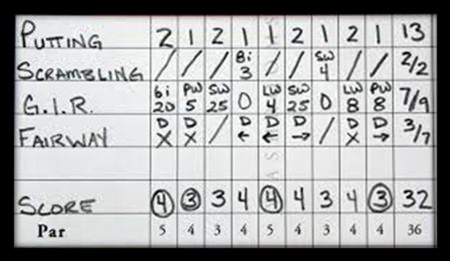“Guaranteed to take strokes off your game;” was last week’s opening gambit suggesting you start keeping your own stats. The stats in question were Driving, GIR, Scrambling and Putting. After defining each, some basic instruction was offered, along with targets based upon handicap grouping. Now to part two.
The card above shows what a pro might take note of, and how. It shows 13 putts for the first nine, including five one-putts. Two from two in scrambling; chipping an 8-iron to three-feet, and a sand-wedge to four. GIR shows seven from nine greens in regulation, as well as noting distance from hole. Finally driving; three from seven fairways hit, with two missing right and two left. This is an illustration on notation. It shows how golfers could record their round for the purposes of analysis.
So much for the pros, now to us amateurs where I recommend one addition: record a plus, a minus or a half (ie. +, -, or 0) against each hole depicting your net result against par – as in a par competition. Don’t expect to match or beat par very often – about one round in ten would be doing well.
Once you have accumulated ten cards, start compiling your own spread-sheet on Microsoft Excel, some other golf software or in hard-copy on your newly acquired Golf Diary. Allow one line entry per round showing date, course (include tees), results of each stat, net score and result against par. You are now closer to identifying where your game offers most improvement.
 Keeping own stats – a pro’s example.
Keeping own stats – a pro’s example.
A meaningful improvement in driving and GIR stats requires more than this modest column can manage. Suffice to repeat what was said last week; play your natural shape shot away from trouble, and always aim for the middle of the green. Genuine ball-striking improvement will probably require swing change, and that requires an accredited teaching pro – which this column is not.
Driving/GIR Goals: As a rough rule-of-thumb, to break 90 you should hit three greens; to break 80, eight greens; to break 70, 13 greens.
Putting: No other area of the game is likely to offer more in shot-reduction than the putting surface. As stated last week, there is no physical reason why we can’t putt as well as the pros, yet the difference between their putting performance and ours is huge. Reducing three-putts will make a significant difference. Two important keys here are distance control and knowing where to leave your lag-putt.
Last week the suggestion was made to search the net for distance-control drills. Possibly the best I’ve come across is this one, based entirely on feel.
First, accept that better putters focus more on distance than they do direction. Second, learn how to putt a certain distance through the feedback of feeling in the hands. Choose a flat putting surface with lengths of 10, 25, and 50 feet. Try ten putts from each distance, concentrating on two things: hitting the putter’s sweet-spot and remembering the feeling of each putt. Keep your eyes fixed at the address position after each putt (don’t look up), and state out loud where you think the ball finished, e.g. “short right, 3-feet”, etc. Then check your estimate against actual.
After a while your guesses will improve. At that point start putting using the feel for that particular length. It’s feedback you’re after, immediate feedback of the feel you know your hands give you when you stroke a ball 10, 25, or 50-feet. This feedback can be felt far easier when you do not look at the hole after putting. Be warned, this is not a five-minute exercise.
When lag putting, know the ground around the hole. Know where you want the ball to finish, or not finish. Avoid leaving yourself a downhill or breaking putt. Should your ball go past the hole, always learn from the path it takes.
Scrambling: Last week we suggested you become good at the basic chip-shot, a chip-and-run shot played from a good lie close to the green. Select a lofted club – enough to land on the flat part of the green – and incorporate your putting stroke. In short, this chip is a putt with a lofted club, and yes – you are going for that feel.
Note to the high-handicapper; when chipping to a green that is downhill and down-grain, ensure you are long – always.
Conclusion: We set out trying to improve your game without it costing an arm or a leg. If this proves to be the case then between us, we have succeeded. If your problems persist, I recommend you visit a teaching pro. If that doesn’t work I suggest you purchase a bar beer which should, after a few months, eliminate your golfing problems entirely.
Happy golfing,
Golfnutter




